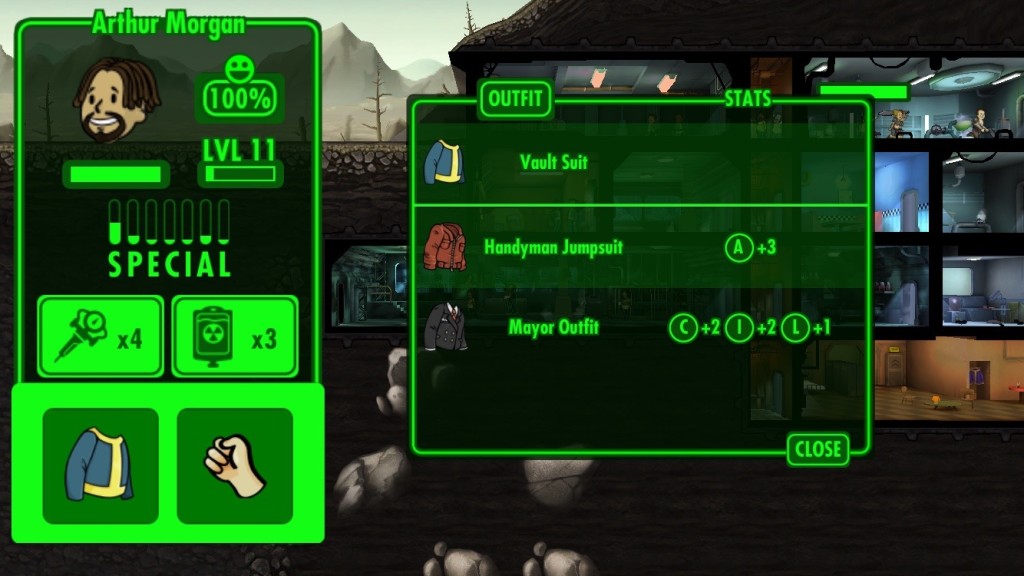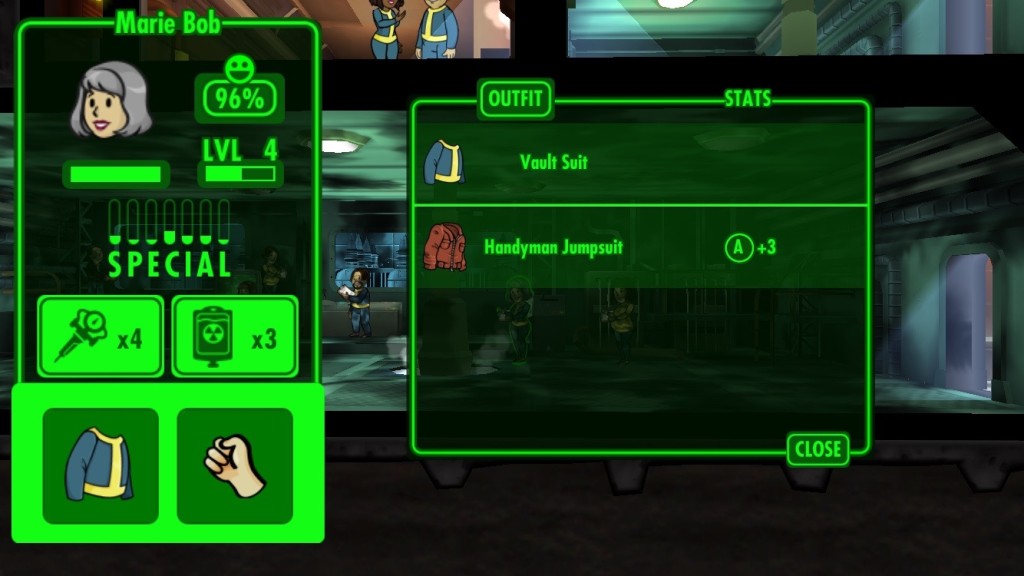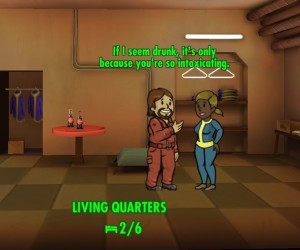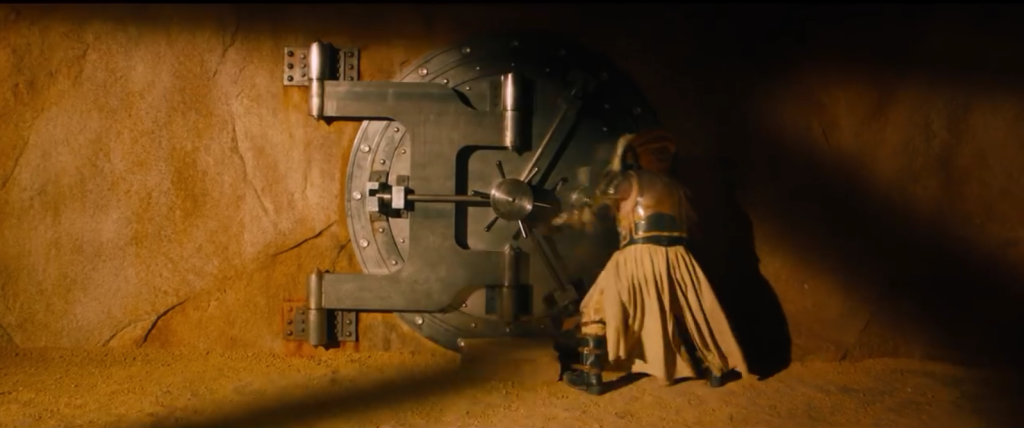Recently when I take breaks from work, I’ve been firing up Fallout: New Vegas on my PS3 (technically I suppose you could argue that this is also work– preparation for NCA this November!– but somehow I don’t think many people would buy that argument). In combination with the recently released iPhone game Fallout Shelter, they’ve been keeping me pretty entertained and not too buried in studying.
Overall, I’m a big fan of the Fallout games I’ve played. Fallout 3, while it probably wouldn’t rank in my top 10 games, definitely ranks as among the most enjoyable and memorable gaming experiences I’ve ever had. By and large I think they do a lot of things right. But these last few weeks there’s been some things bothering me about the way the games deal with gender.
For now, I want to talk about Fallout Shelter.* The game itself is pretty simple: You’re the overseer of a vault that provides refuge for people after nuclear war. Your job is to manage the happiness of the people in the vault (dwellers), along with the resource levels for food, water, and power. You have both male and female dwellers, and there’s no difference between them as far as their stats go: as opposed to what was common in many older game mechanic systems, female dwellers are just as likely to be strong as male dwellers. However, that doesn’t stop the game from creating mechanics that differentiate between the male and female dwellers.
The game allows you to equip your characters with outfits and weapons in order to increase their stats. However, there are a few outfits that, inexplicably, only male dwellers can wear. One of these is a ninja suit. The other is the Mayor Outfit.

While male dwellers can equip the Mayor Outfit, it doesn’t show up in the inventory for female dwellers to equip (see following image)

Why is she named Marie Bob? I don’t even know it was probably late and it seemed like a good idea at the time.
I’m slightly less concerned with the gendered implications of ninjas, though perhaps I shouldn’t be. But it infuriates me that in the world of Fallout Shelter, only males can be Mayors– not even that, it’s only males who can dress up as mayors.
While male and female characters may not have any differences in their base stats (which are randomly assigned for all dwellers), having some outfits available to male dwellers only (and I believe some are likewise only available to female dwellers) has similar implications to having male and female characters have different stats: the game mechanics present males and females as being more suitable for certain roles. By doing this through the application of outfits, however, rather than base character stats, it does function to reveal the something of the socially constructed nature of gender roles. Males have traditionally masculine roles of leadership (and, according to the outfit’s stats, additional charisma, intelligence, and luck). While the association between males, men, and masculinity is pre-existing in Fallout Shelter and is left unquestioned, the use of outfits does serve to highlight the ways in which what we see as natural often really isn’t but instead functions on circular reasoning.
Beyond the gendered nature of the clothing in-game, the division of outfits (and through them of roles and characteristics) also makes me wonder about what the developers think about me as the player. After all, the player in Fallout Shelter takes on the role of the vault’s overseer; if a female can’t be mayor, surely she can’t be an overseer either. I am excluded, however tenuously, from being the player of this game. Given recent controversies about women in gaming (and here I am ignoring important distinctions between the categories of female and woman, in following with much of the popular discourse around this topic), including gamergate and the International e-Sports Federation comments about having created segregated divisions for competitions in order to “promote e-Sports as a legitimate sports,”** this isn’t making something out of nothing. Issues involving gamers’ legitimacy and ability to be gamers (however that is defined) are important when you think about not only who is “allowed” to play games but also who is taken into account when decisions about who will be represented (and how people will be represented) in games are made. Not allowing the female dwellers to wear the mayor outfit sent the message to me that I was not taken into consideration when this game was being made. I felt alienated from the game. Although this wasn’t the only reason, I’ve largely stopped playing.
Not to fear, though! Fallout Shelter has a role that’s just for females: breeders.
I use the term breeder here deliberately. The game mechanics don’t technically require you to use your female dwellers to pop out baby after baby, but it becomes clear after just a few minutes of playing that this is what the game intends. To not impregnate your female dwellers makes your job as the overseer much, much harder. Patricia Henderson also points to this problem in Fallout Shelter in her review of the game for Kotaku:
In a way, it feels like “proper” play is to have as many pregnancies as possible, so that you can keep making your vault bigger and bigger—which is the entire point of the game. The game seems to particularly encourage you to have as many pregnancies as possible because pregnant women in the game have higher happiness ratings, and the happier your vault is, the more rewards you get.
At first, that seems to be all there is to the game mechanic; as Henderson concludes, “It all makes sense mechanically, given what the game is about, but still. It’s weird. Not a big deal or anything, but weird.” As I’ve played, however, I’ve found the “pregnancy mechanic” in Fallout Shelter to be more than just weird: it presents a discourse that presents ideologies about pregnancy, masculinity and femininity, and even sex education.
How pregnancies work is is pretty simple: a male and a female dweller will flirt for awhile, if they get along then they disappear into a backroom, the player only sees a cloud of smiley faces for a few seconds, and then both dwellers emerge, the male inevitably smiling and the female moving slowly and inevitably pregnant. Already, there are several problematic ideas that the game mechanics is putting forth:
- The way for males to be happy is for them to have sex
- The way for females to be happy is for them to be pregnant
- If you have sex, you will get pregnant
and die***
Once a female dweller is pregnant, the number of things they can do greatly decreases. While they are no less efficient at most work, in case of an emergency such as a fire breaking out or a radroach infestation, pregnant characters immediately run out of the room screaming rather than staying to handle the situation. Pregnancy, it seems, makes people unable to squish bugs or put out a fire. While there may be some degree of logic to this, given that prolonged exposure to both smoke inhalation from the fires and radiation from the radroaches probably aren’t ideal during pregnancy, there is no reason to have every woman run out of the room with her arms flung up in terror. Given a long history of discrimination against pregnant workers, including denying jobs to women who aren’t pregnant because job requirements might diminish their reproductive potential, such representations are much more harmful than humorous.
None of that, however, even really begins to get at the idea of how the game mechanics position the female dwellers as an objectified resource rather than as participants in the community. Their main contribution is their ability to have children rather than any work they can do. As I’ve played the game, I didn’t just find this weird, I found it horrifying.
Fallout Shelter asked me to treat the female dwellers as livestock rather than as individuals. The game allows you to have one male impregnate multiple females (as far as I know there is no limit, although the game does prevent characters who are genetically linked from reproducing) in a row; females, however, are much more limited in their partnering. While there are certainly biological restriction on how often a female can be pregnant, the game has no option for characters to have sex outside of the purpose of reproduction, meaning that there is both no non-heterosexual sex and that pregnant women do not have the option of having sex. Heteronormativity rules the day.
Women become seen as entirely equated with their reproductive capacity: To be female is to be able to be pregnant is to be a woman. It is this reduction of what some women and some females are capable of (which doesn’t even begin to address the matter of whether or not they want to) that leads to treating women as a resource. It is not a matter of women “naturally” needing to be protected, but rather the way in which they are framed.
Fallout Shelter ends up with some having some similarities to another recent media release, Mad Max: Fury Road (alternately titled There and Back Again, an Road Warrior’s Tale by Imperator Furiosa) that go beyond the fact that both of them take place in a post-apocalyptic setting. In Mad Max: Fury Road, Immortan Joe keeps his “brides” (a grossly euphemistic term for women he imprisons and forces to have sex with him) behind a literal bank vault door.
In Fallout Shelter, women are likewise kept behind a vault door. The circumstances are not identical, to be sure: Fallout Shelter allows female dwells who aren’t pregnant to leave the vault, and male dwellers also generally stay within the vault, whereas in Mad Max: Fury Road Immortan Joe keeps a small group of women who do not evidence any physical mutations locked away so the he alone can have sexual access to them. But in the end, a lot of the message is the same: women are a resource, and one that needs to be carefully kept under lock and key in order to protect “the future.”
The Furious Five (a much better name for Angharad, Toast the Knowing, Capable, Cheedo the Fragile, and the Dag, in my opinion, than “Immortan Joe’s wives” or “the brides,” since the latter two continue to frame the woman based on their unwilling relationship with Immortan Joe rather than having them claim any degree of agency or freedom… which is, after all, a large part of what the movie is about) alone serve as a counterexample to claims that (pregnant) women must be protected (protected, it is worth noting, in many cases from other men–while this is not the case in Fallout Shelter, Immortan Joe locks the Furious Five away not so much as to protect them from the dangers of the post-apocalyptic wasteland but rather to maintain sole access, something that is further evidenced by his use of chastity belts to which only he holds the key).
The idea of women as breeders and of being unsuited to leadership positions works right alongside the literal objectification of women. Women are positioned as lacking agency. It’s important to recognize, of course, that when such ideas crop up, they likely aren’t malicious. Instead, it’s a matter of existing power structures being reproduced over and over again because they’re seen as natural– it’s the way things are, it makes sense, and they can’t be any other way. The way in which this operates in the video game industry is something that Fron et. al explain brilliantly in their paper on hegemonies of play.
Looking at Fallout Shelter and Mad Max: Fury Road, it becomes clear how these hegemonies can operate. Of course in a post-apocalyptic wasteland you need to reproduce. And of course women are the only ones who can get pregnant, and of course you need to protect your future, and of course you need to make sure that you can do that, and of course since women can get pregnant you need to protect them… and so on and so forth. These ideologies get replicated in the media we consume. The problem comes when it gets replicated uncritically.
Fallout Shelter never works to question these ideologies that view women as a resource for reproduction. There is no game mechanic, for example, that has some female dwellers not be happy at all to be pregnant. There’s nothing that takes into account the strain that multiple pregnancies, particularly multiple pregnancies one right after the other, can have on a woman’s body (though I suppose an explanation for this could be handwaved away by the liberal application of stimpacks [healing items in the Fallout universe], given that the player character’s mother dies during childbirth in Fallout 3 this seems unlikely). Not including mechanics like these in the game is a design decision rather than a reflection of the way the world “naturally” works.
The point is not to say that Mad Max: Fury Road is better than Fallout Shelter (Mad Max: Fury Road has plenty of problems of its own, and there are a lot of things that Fallout Shelter does beautifully). Instead, it’s to point out the ways in which the way we look at the world can’t be taken for granted when we design media. The issue isn’t necessarily that a story depicts a story in which part of the plot involves women fulfilling a certain role, it’s in how that story handles that element.
*I’m planning on writing a separate post about Fallout: New Vegas. Also, it’s worth noting that I’m well aware that Fallout 3 and Fallout Shelter were done by Bethesda while Fallout: New Vegas was done by Obsidian. However, regardless of their different developers, they are still part of the same overall world. I freely admit that, if I’d ever gotten around to playing Fallout 1 and Fallout 2 I might make a bigger point of this distinction, but as it is I’m happy to just consider them all to be Fallout.
**The IeSF has since opened all its tournaments to women
***While the “and die”is a reference to Mean Girls (as should be obvious from the linked video) rather than anything that actually happens in the game, I did have one character glitch so that she is permanently pregnant. As far as I can tell, she will remain so forever.


